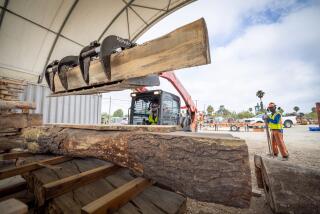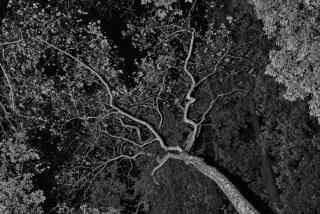Avoid a crushing blow: Catch the weak trees before they fall
- Share via
The news footage and photos are always dramatic -- a fallen tree, roots in the air, sprawled across the crushed roof of a car or house. They seem to topple after a soaking rain that has gone on for days, or a big blow.
But why do trees suddenly fall, and how can homeowners make sure that one won’t land on their house or car?
“Of the hundreds of thousands of trees growing in Southern California, only a minuscule amount topple, but they’re very noticeable,” said West Hills consulting arborist Robert Hansen. For one thing, many of the trees that fell during the recent heavy rains were growing in city parkways, easily reached by news crews.
“Even on TV you can see why these fall,” Hansen said. “The roots grow on only one side of the tree because of the curb.” Because the biggest roots are usually on the house side of the tree, it tips like it was hinged, right into the building.
A good arborist can spot most problems that eventually bring trees down. “Not all, but most,” he said. “Most that fall in a storm or wind were already candidates for failure.”
But during the series of storms this month, some trees fell for no discernible reason, said Jan Scow, a consulting arborist in Sherman Oaks who has spent the last few weeks looking at many. On one seemingly cursed residential block in Studio City, several species in different kinds of soil fell within sight of one another.
So how do you know whether big trees on your property might be at risk? Arborists assess risk by the type of tree, the tree’s size and the damage it might cause. Evergreen trees, pines in particular, are more likely to come down because their canopy is always present and it’s thick and heavy -- “a windsail effect,” Scow said.
Added Hansen: “I’ll bet half the trees that fell in the last storm were Aleppo pines. You won’t ever find Bob Hansen napping under one,” he said, only half-kidding. “They shouldn’t be planted within striking distance of a home.”
Another pine that frequently falls is the majestic Italian stone pine. “They can have a spread of 80 feet with roots that fan out for only 10.” One beefy specimen was lying on a sidewalk in West Los Angeles after the last series of storms, the latest of several on that street to topple in storms.
“Every tree I saw on the news was either a pine or a blue gum,” said Greg Applegate, a consulting arborist in Tustin. Fast-growing trees, including eucalyptus, may topple because of problems that begin while in a nursery container, such as circling or girdling roots, he said. Very old blue gums also get a fungus called sulfur conk, which weakens the base of the trunk and may cause them to fall.
Deciduous trees such as crape myrtle and Modesto ash can be more stable because they lose their leaves before winds and winter storms arrive, but not always. Samuel Knapp, author of the 10-page pamphlet “A Guide for Safe, Healthy and Beautiful Trees” and a consulting arborist in Riverside, said, “Sycamores are very stable, but jacarandas are less so because they’re not as adapted to our climate.”
Big trees are obviously more of a risk because they are heavy, and those close to parking spots, sidewalks or homes are a bigger risk because they can do damage.
In the recent rains, a huge oak at Occidental College came down but did no damage because it was in a large, open area. Knapp advised leaving it there, on its side, with only a little compensating pruning. “It still looks very handsome,” he said.
This grand oak is still rooted in the ground and will continue to grow, but most trees that topple must be taken out. If the roots are also removed with a root grinder, and any drainage or soil problems are fixed, planting another tree in the same spot is possible, after the soil has settled for several months and the sawdust from the grinding has decayed.
In heavy, prolonged rains, water on the foliage makes trees heavier and soils can turn to soup. This is especially likely in low-lying areas in the yard where water accumulates. Scow said that standing water around a big tree is a cause for concern. Healthy trees may topple because the soil fails, not the roots. “It becomes too soggy, slippery and has no cohesion. There’s nothing for the roots to grab on to.”
Scow said signs of imminent failure of the soil include cracks in the ground near the tree or when trees suddenly move a lot in the wind.
Trees sometimes fall because they are lopsided, with too much canopy on one side, or they may be leaning, often caused by being planted too close together or too close to the house. Both of these potential problems can be fixed with careful pruning. Leaning trees have even been known to straighten themselves after corrective pruning, Knapp said.
It’s more difficult to spot a lopsided root system, but sometimes you can see that the base of the tree does not have a sturdy tripod-like system of roots radiating from it. Paving or buildings may cause lopsided roots, but more often, said Knapp, the tree simply got off to a poor start in the nursery container.
Other things to look for, suggests Hansen, are mushrooms or bracket fungus (conks) that might indicate fungus or rot, and recent work around trees (such as sprinklers or sewer drains) that may have damaged or cut major roots.
Regular pruning and thinning and care by qualified arborists can certainly lessen the chance that a tree develops the problems that eventually cause it to topple, but an expert’s appraisal is also a good idea once in a while for really big trees. Arborists can spot trouble coming, and “it’s important to remove high-risk trees before they fail,” Hansen said.
*
(BEGIN TEXT OF INFOBOX)
An aborist can get to the root of the problem
If you suspect that a tree might topple because it is extremely tall or massive, or it’s growing in a too-confined place, whom can you call to assess the risk? Tree professionals known as arborists. They may be certified, consulting or registered, depending on their professional affiliation. Here’s a who’s who:
* Certified arborist: Has passed the International Society of Arborists’ exam and has a minimum of three years’ experience in some aspect of tree care. Most are with tree-trimming firms, though some are in related professions or are consultants only.
* Board-certified master arborist: Has a minimum of seven years’ experience and must pass a more extensive diagnostic exam of the International Society of Arborists. This arborist has “advanced levels of knowledge in all aspects of tree care,” according to the group. Consultations by certified or certified master arborists run $50 an hour and up. To find either a certified or certified master arborist, go to www.isa-arbor.com.
* Consulting arborist: A member of the American Society of Consulting Arborists who offers “advice and mediation ... to bring a comprehensive, objective viewpoint to the diagnosis, appraisal and evaluation of arboricultural issues,” according to the professional organization. Members receive continuing education every two years and must abide by a code of ethics.
* Registered consulting arborist: Has successfully completed the requirements of the American Society of Consulting Arborists’ rigorous Consulting Academy program and meets stringent requirements for technical education and experience. Fees for consulting arborists vary greatly; registered consulting arborists usually charge $125 to $250 an hour. There’s a listing of both consulting and registered arborists at the group’s website, www.asca-consultants.org.


